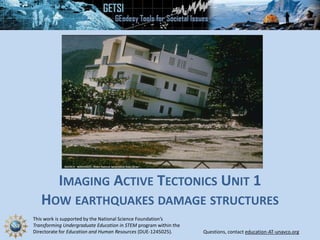
Unit 1 Pre-exercise lecture on how earthquakes damage structures
- 1. This work is supported by the National Science Foundation’s Transforming Undergraduate Education in STEM program within the Directorate for Education and Human Resources (DUE-1245025). Questions, contact education-AT-unavco.org IMAGING ACTIVE TECTONICS UNIT 1 HOW EARTHQUAKES DAMAGE STRUCTURES
- 2. OUTLINE • How earthquakes cause damage • How might that damage affect society? • What do we need to know to prepare?
- 3. DAMAGE! In what ways do earthquakes cause damage to structures, and why? Think on your own for a minute, and then confer with your neighbor for a minute, and come up with a list.
- 4. DAMAGE! strain! shaking • resonance • toppling • swaying liquefaction • differential movement • sinking landsliding • differential movement • burial fault offset • differential movement secondary effects • fire • flooding
- 5. NEWTON’S SECOND LAW AND INERTIA F = m a force = mass x acceleration Inertial Response Building at Rest Ground Motion
- 6. NEWTON’S SECOND LAW AND INERTIA D’Alembert’s principle: the inertial force on a mass resisting acceleration is of equal magnitude and in the opposite direction. Inertial Response Building at Rest Ground Motion
- 7. YIELD STRAIN Inertial forces cause shear strains in a structure and its components. If any element exceeds its yield strain, it will be permanently damaged. Lateral load Yield Point Ductile Brittle Deflection Elastic Range
- 8. TOPPLING AND ROTATION One response of a structure to lateral inertial forces is to rotate like an inverted pendulum. If it is not secured at its base, it may topple. Free-standing
- 9. TOPPLING AND ROTATION On the other hand, if it is secured at its base, it must absorb the inertial force internally, possibly leading to yielding at its base. Free-standing Fixed-base
- 10. SWAYING AND RESONANCE Structures have their own natural frequencies, related to their dimensions and stiffness. If they are shaken at those frequencies, they will resonate. Download video from: http://www.iris.edu/hq/programs/%20e ducation_and_outreach/videos#P
- 11. SITE AMPLIFICATION Seismic waves traveling from stiff rock to softer material (e.g. from basement to a sedimentary basin) typically experience an increase in shaking amplitude. Why?
- 12. SITE AMPLIFICATION Conservation of kinetic energy requires that amplitude of shaking increase when waves travel into less stiff materials. This can strongly affect the likelihood of building damage. small x large = large x small amplitude stiffness amplitude stiffness
- 13. LIQUEFACTION Water saturated Loose sediments Sand injected into overlying area upon shaking
- 14. LIQUEFACTION
- 15. LIQUEFACTION Above: Christchurch, New Zealand sand boils (2011 earthquake) Right: Christchurch, New Zealand road affected by liquefaction
- 16. BUILDING DAMAGE FROM SHAKING
- 17. LANDSLIDES Above: Wenchuan, China, 2008 Right: El Salvador, 2001
- 18. FAULT OFFSET Above: Horizontal offset from 1906 San Francisco earthquake (Marin County) Right: Vertical offset from 1999 Taiwan earthquake
- 19. TRANSPORTATION CORRIDOR DAMAGE Above: South Napa, CA earthquake 2014 Right: Northridge, CA earthquake 1994
- 21. SAN FRANCISCO, 1906 The worst damage in San Francisco was caused by the fire following the earthquake, not the earthquake itself. (Why?)
- 23. Port of Seattle Major highway
- 24. EARTHQUAKE PROBLEMS! In what ways might earthquake damage to structures (buildings and infrastructure) affect society? Think on your own for a minute, and then confer with your neighbor for a minute, and come up with a list.
- 25. RISK VS HAZARD Informally, people use these terms interchangeably, but in the natural disasters field, they have specific, different definitions. Hazard refers to the probability of a particular disaster–e.g. earthquake hazard = the likelihood of a given size of earthquake occurring. Risk refers to the likely implications of such a disaster, and usually is quantified in dollars–e.g. uninsured earthquake risk in LA is ~ $100 billion.
- 26. PREPARING FOR EARTHQUAKE HAZARDS What information might we want to have in order to characterize and prepare for future earthquake risk and hazard? Think on your own for a minute, and then confer with your neighbor for a minute, and come up with a list.
Editor's Notes
- Image source: NOAA/NGDC, open domain
- Image source: IRIS (Integrated Research Institutes for Seismology) image released under Creative Commons. Consider downloading the entire animation to show to the class: https://www.iris.edu/hq/inclass/animation/buildings__bedrock_effects_of_amplification__liquefaction
- Image source: IRIS (Integrated Research Institutes for Seismology) image released under Creative Commons. Consider downloading the entire animation to show to the class: https://www.iris.edu/hq/inclass/animation/liquefaction_during_the_1906_san_francisco_earthquake
- Image source: NOAA/NGDC, open domain
- Image sources: Left: "Christchurch quake, 2011-02-22" by Tim - Christchurch quake, 2011-02-22. Licensed under CC BY-SA 2.0 via Commons - https://commons.wikimedia.org/wiki/File:Christchurch_quake,_2011-02-22.jpg#/media/File:Christchurch_quake,_2011-02-22.jpg Right: "25 Feb 2011 River Road" by Schwede66 - Own work. Licensed under CC BY-SA 3.0 via Commons - https://commons.wikimedia.org/wiki/File:25_Feb_2011_River_Road.jpg#/media/File:25_Feb_2011_River_Road.jpg
- Image source Left: "Izmit eart2". Licensed under Public Domain via Commons - https://commons.wikimedia.org/wiki/File:Izmit_eart2.jpg#/media/File:Izmit_eart2.jpg Right: M. Celebi. U.S. Geological Survey - http://www.ngdc.noaa.gov/hazardimages/picture/show/385
- Image sources: Left: Dave Wald, U.S. Geological Survey. http://landslides.usgs.gov/learn/photos/international/landslides_from_the_sichuan__wenchuan__earthquake__china__may_2008/img_0843.jpg Right: "El Salvador slide.” Licensed under Public Domain via Commons - https://commons.wikimedia.org/wiki/File:ElSalvadorslide.jpg#/media/File:ElSalvadorslide.jpg
- Image source Left: NOAA http://www.ngdc.noaa.gov/hazardimages/picture/show/41 Right: NOAA http://www.ngdc.noaa.gov/hazardimages/picture/show/941
- Image source Left: USGS http://gallery.usgs.gov/photos/09_03_2014_l5GSj77iid_09_03_2014_6#.VlQc6d-rR39 Right: http://www.ngdc.noaa.gov/hazardimages/picture/show/381
- Fire and lateral spread caused by the 1994 Northridge earthquake. The ground in the lateral spread slid to the right, riding on liquefied sediment, and opened the fissure. Extension across the fissure stretched and broke the natural gas pipeline, causing the fire. Image source: M.J. Rymer, U.S. Geological Survey http://geomaps.wr.usgs.gov/sfgeo/liquefaction/image_pages/northridge_lateral.html
- Image source: "San Francisco 1906 fire 02 DA-SN-03-00958" by Harry Sterling Hooper - High resolution download from http://www.dodmedia.osd.mil/DVIC_View/Still_Details.cfm?SDAN=DASN0300958&JPGPath=/Assets/Still/2003/Army/DA-SN-03-00958.JPG.. Licensed under Public Domain via Commons - https://commons.wikimedia.org/wiki/File:San_Francisco_1906_fire_02_DA-SN-03-00958.JPEG#/media/File:San_Francisco_1906_fire_02_DA-SN-03-00958.JPEG
- Image source: San Francisco Water Power Sewer Public Utility http://www.sfwater.org/
- Image source: Washington Department of Natural Resources via the King County website http://www.kingcounty.gov/services/environment/water-and-land/flooding/flood-control-zone-district/local-hazard-mitigation-plan-update/hazard-maps.aspx#liquefaction